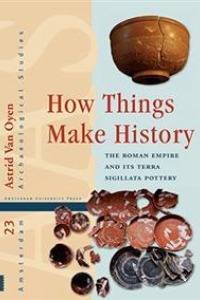
Liknande böcker
LRFW 1. Late Roman Fine Wares. Solving problems of typology and chronology.: A review of the evidence, debate and new contexts
Bok av Miguel Ángel Cau
"ROMAN AND LATE ANTIQUE MEDITERRANEAN POTTERY". In November 2008, an ICREA/ESF Exploratory Workshop on the subject of late Roman fine wares was held in Barcelona, the main aim being the clarification of problems regarding the typology and chronology of the three principal table wares found in Mediterranean contexts (African Red Slip Ware, Late Roman C and Late Roman D). The discussion highlighted the need to undertake a similar approach for other ceramic classes across the Mediterranean provinces. In addition, it was perceived that ceramic studies are often dispersed and in such a variety of publications that it is difficult to follow progress in this vast field. Therefore, a series devoted to Roman and late Antique pottery in the Mediterranean was proposed to serve as a reference point for all potential authors devoted to pottery studies on a pan-Mediterranean basis. The creation of such a series would not only serve as a means of publishing the results of the ICREA/ESF workshop but also as a network for publication of in-depth monographs devoted to archaeological ceramics of the Mediterranean in the Roman and late Antique periods. With this first volume on ceramic assemblages and the dating of late Roman fine wares, Archaeopress launch this new series devoted to the publication of ceramics in the Roman Mediterranean and outlying territories from the late Republic to late Antiquity. Contents: Introductions (a) (M.A. Cau, P. Reynolds, M. Bonifay); (b): LRFW Working Group (text by M.A. Cau, P. Reynolds and M. Bonifay), An initiative for the revision of late Roman fine wares in the Mediterranean (c. AD 200-700): The Barcelona ICREA/ESF Workshop; (c) LRFW Working Group (text by P. Reynolds, M. Bonifay and M.A. Cau), Key contexts for the dating of late Roman Mediterranean fine wares: a preliminary review and 'seriation'; 1) Ceramica e contesti nel Quartiere Bizantino del Pythion di Gortina (Creta): alla ricerca della "complessita" nella datazione (E. Zanini and S. Costa); 2) Coins, pottery and the dating of assemblages (R. Reece); 3) Late Roman D. A matter of open(ing) or closed horizons? (J. Poblome and N. Firat); 4) A note on the development of Cypriot Late Roman D forms 2 and 9 (P. Reynolds); 5) Chronologie finale de la sigillee africaine A a partir des contextes de Chaos Salgados (Mirobriga?): differences de facies entre Orient et Occident (J.C. Quaresma); 6) Sigillatas africanas y orientales de mediados del VI d. C. procedentes de los rellenos de colmatacion de una cisterna de Hispalis (Sevilla). Los contextos de la Plaza de la Pescaderia (J. Vazquez Paz and E. Garcia Vargas); 7) A 7th century pottery deposit from Byzantine Carthago Spartaria (Cartagena, Spain) (P. Reynolds); 8) Contextos ceramicos del siglo VI d.C. de Iluro (Hispania Tarraconensis) (V. Revilla Calvo); 9) Note sur les sigillees orientales tardives du port de Fos (Bouches-du-Rhone, France) (F. Marty); 10) L'agglomeration de Constantine (Lancon-de-Provence, Bouches-du-Rhone): deux contextes du VIe siecle (G. Duperron and F. Verdin); 11) Un depot de ceramiques du debut du Ve s. apr. J.-C. sur le site de la rue de la Douane a Porquerolles (Hyeres, Var) (E. Pellegrino); 12) Un ensemble de ceramiques de l'extreme fin du IVe s. apr. J.-C. sur le site du n Degrees43 de l'avenue du XVe Corps a Frejus (Var) (E. Pellegrino); 13) Campiani: un ensemble du IIe siecle a Lucciana (Haute-Corse) (S. Lang-Desvignes); 14) Fine wares from Beirut contexts, c. 450 to the early 7th century (P. Reynolds); 15) Le mobilier ceramique de la citerne C4 de la Maison de la Rotonde a Carthage (A. Bourgeois).







